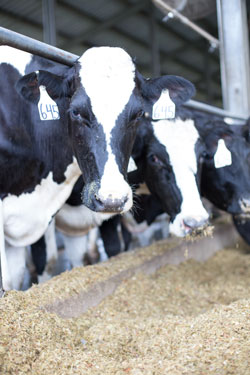 Limited pen space on-farm often ties our hands when we attempt to develop a grouping strategy. The options, such as separating cows based on stage of lactation, reproductive status or body condition, are endless. Yet, one strategy that deserves renewed consideration is grouping cows by parity.
Limited pen space on-farm often ties our hands when we attempt to develop a grouping strategy. The options, such as separating cows based on stage of lactation, reproductive status or body condition, are endless. Yet, one strategy that deserves renewed consideration is grouping cows by parity. As Rick Grant noted in the September Miner Institute Farm Report, many heifers will struggle to meet their genetic potential when competing with older cows in a mixed parity pen.
It's not news that, when comingled with older herdmates, first-calf heifers will have lower dry matter intakes, spend less time lying down and produce less milk than when they are housed with similarly aged counterparts. European research found that heifers housed in separate pens for one month after calving boosted their milk yield by 506 pounds per lactation and had a lower ketosis incidence, noted Grant.
Furthermore, data from Spain has shown that heifers mixed with older cows lose more body weight and produce milk less efficiently during early lactation. When forced to compete, first-calf heifers also had a lower milkfat test, lower drinking time and reduced rumination.
The bottom line, noted Grant: it is expected first-calf heifers will lose about 10 percent of their milk yield when competing with older cows.
To top it off, the impact worsens when mixed parity pens are overcrowded. Research conducted at the Miner Institute showed that ramping up stall and headlock density from 100 to 113 percent caused the spread in milk production between mature cows and first-lactation animals to widen from 5.9 to nearly 14 pounds per cow per day.
Grant added that, while dry matter intake doesn't begin to drop for older cows until bunk space reaches 16 inches per cow, the same isn't true of younger animals. Heifers' feed intake began to decline as soon as bunk space reached 24 inches per cow in mixed pens.
To shed light on why these reductions occur, the Miner Institute began conducting research on mixed pens of cows (70 percent mature animals; 30 percent first-calf heifers). Preliminary data showed that, when examining stall preference, heifers occupied the most competitive stalls only 5 percent of the time. Previous research also indicates that heifers ruminate up to 40 percent less when they are in a stall that is preferred by older cows.

The author , Amanda Smith, was an associate editor and an animal science graduate of Cornell University. Smith covers feeding, milk quality and heads up the World Dairy Expo Supplement. She grew up on a Medina, N.Y., dairy, and interned at a 1,700-cow western New York dairy, a large New York calf and heifer farm, and studied in New Zealand for one semester.










